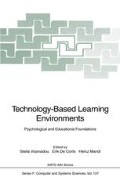Abstract
A model-centered science curriculum is developed and implemented to help middle school students learn to reason with qualitative explanatory models that underlie scientific phenomena. The curriculum focuses on concepts important for understanding floating and sinking, coordinating traditional laboratory experiments with interactive computer tasks which permit students to inspect, manipulate and predict with models of the underlying theoretical entities.
Access this chapter
Tax calculation will be finalised at checkout
Purchases are for personal use only
Preview
Unable to display preview. Download preview PDF.
References
American Association for the Advancement of Science. (1989) Project 2061: Science for all Americans. Summary report. Washington, DC: AAAS.
Andaloro, G., Donzelli, V., Sperandeo-Mineo, R.M. (1991) Modelling in physics teaching: The role of computer simulation. International Journal of Science Education 13, 243–254.
Brown, A. L. (1989) Analogical learning and transfer: What develops? In: S. Vosniadou, A. Ortony (eds.) Similarity and analogical reasoning, 369–406. Cambridge, England: Cambridge University Press.
Chi, M.T.H., Feltovich, P.J., Glaser, R. (1981) Categorization and representation of physics problems by experts and novices. Cognitive Science 5, 121–152.
Chi, M.T.H., Glaser, R., Rees, E. (1982) Expertise in problem solving. In: R. Sternberg (ed.) Advances in the psychology of human intelligence, 7–70. Hillsdale, NJ: Erlbaum.
Clement, J.J. (1982) Students’ preconceptions in introductory mechanics. American Journal of Physics 50, 66–71.
Clement, J.J. (1991) Non-formal reasoning in experts and in science students: The use of analogies, extreme cases, and physical intuition. In: J. Voss, D. Perkins, J. Siegel (eds.) Informal reasoning and education, 345–362. Hillsdale, NJ: Lawrence Erlbaum Associates.
Gentner, D., Stevens, A.L. (1983) Mental models. Hillsdale, NJ: Lawrence Erlbaum Associates.
Halloun, I. A., Hestenes, D. (1987) Modeling instruction in mechanics. American Journal of Physics 55, 455–461.
Heller, J. I., Reif, F. (1984) Prescribing effective human problem solving processes: Problem description in physics. Cognition and Instruction 1, 177–216.
Hestenes, D. (1987) Toward a modelling theory of physics instruction. American Journal of Physics 55, 440–454.
Hestenes, D. (1992) Modeling games in the Newtonian world. American Journal of Physics 60, 732–748.
Johnson-Laird, P.N. (1989) Mental models. In: M. I. Posner (ed.) Foundations of cognitive science, 469–499. Cambridge, MA: The MIT Press.
Kuhn, D., Phelps, E. (1982) The development of problem-solving strategies. In: H. Reese (ed.) Advances in child development and behavior, Vol. 17, 1–44. New York: Academic Press.
Larkin, J.H. (1983) The role of problem representation in physics. In: D. Gentner, A.L. Stevens (eds.) Mental models, 75–98. Hillsdale, NJ: Lawrence Erlbaum Associates.
Mayer, R.E. (1989) Models for understanding. Review of Educational Research 59, 43–64.
Mestre, J.P. (1992) Cognitive aspects of learning and instruction in science. Pre-College Teacher Enhancement in Science and Mathematics: Status, Issues and Problems. National Science Foundation. (To appear)
Schauble, L. (1990) Belief revision in children: The role of prior knowledge and strategies for generating evidence. Journal of Experimental Child Psychology 49, 31–57.
Siegler, R. S., Crowley, K. (1991) The mitogenetic method: A direct means for studying cognitive development. American Psychologist 46, 606–620.
Sherwood, B., Chabay, R., Larkin, J., Reif, F., Eylon, B. (1991) An integrated treatment of electrostatics and circuits. Unpublished manuscript, Pittsburgh, PA: Carnegie Mellon University.
Smith, C., Snir, J., Grosslight, L., Frenette, M. (1986) Promoting 6th graders’ understanding of density: A computer modeling approach. Technical report. Cambridge, MA: Harvard Graduate School of Education, Educational Technology Center.
White, B.Y., Frederiksen, J.R. (1986) Qualitative models and intelligent learning environments. In: R. Lawler, M. Yazdani (eds.) AI and education: Learning environments and intelligent tutoring systems. Norwood, NJ: Ablex Publishing.
White, B. Y., Horwitz, P. (1987) Thinker Tools: Enabling children to understand physical laws. Technical Report 6470. Cambridge, MA: BBN Laboratories.
Wiser, M. (1987) The differentiation of heat and temperature: History of science and novice-expert shift. In: D. Strauss (ed.) Ontogeny, phylogeny, and historical development, 28–48. Norwood, NJ: Ablex.
Author information
Authors and Affiliations
Editor information
Editors and Affiliations
Rights and permissions
Copyright information
© 1994 Springer-Verlag Berlin Heidelberg
About this paper
Cite this paper
Raghavan, K., Glaser, R. (1994). Studying and Teaching Model-based Reasoning in Science. In: Vosniadou, S., De Corte, E., Mandl, H. (eds) Technology-Based Learning Environments. NATO ASI Series, vol 137. Springer, Berlin, Heidelberg. https://doi.org/10.1007/978-3-642-79149-9_14
Download citation
DOI: https://doi.org/10.1007/978-3-642-79149-9_14
Publisher Name: Springer, Berlin, Heidelberg
Print ISBN: 978-3-642-79151-2
Online ISBN: 978-3-642-79149-9
eBook Packages: Springer Book Archive

